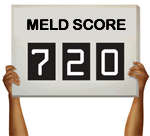By
Liz Highleyman
 As
of 2002, the United Network for Organ Sharing (UNOS) has used
the MELD (Model for End-Stage Liver Disease) scoring system
to classify patients according to their likelihood of survival
and how urgently they need a new liver. The MELD score is comprised
of 3 measures: bilirubin, serum creatinine (a biomarker of kidney
function), and international normalized ratio (INR, a measure
of blood clotting ability).
As
of 2002, the United Network for Organ Sharing (UNOS) has used
the MELD (Model for End-Stage Liver Disease) scoring system
to classify patients according to their likelihood of survival
and how urgently they need a new liver. The MELD score is comprised
of 3 measures: bilirubin, serum creatinine (a biomarker of kidney
function), and international normalized ratio (INR, a measure
of blood clotting ability).
Women
on average have lower creatinine levels than men with similar
kidney function, which makes women's MELD scores lower. This
suggests that an alternative measure of kidney function that
differs less according to sex might reduce transplant disparities.
Investigators identified adults registered on the UNOS liver
transplant waiting list in the U.S. between March 2002 and December
2007. More than 40,000 patients met the inclusion criteria,
of whom 33% were women. The major causes of liver disease were
hepatitis C (40%) and alcohol use (17%).
They researchers looked at differences between women and men
in components of the MELD score, estimated glomerular filtration
rate (eGFR) using the MDRD equation (another kidney measure),
and the probability of liver transplantation and death within
3 months of registration.
Results
 |
Over
3 months of follow-up, 24% of identified patients received
a liver transplant and 9% died. |
 |
Women
had significantly lower serum creatinine levels than men,
despite having similar or worse kidney function (0.9 vs
1.0 mg/dL, respectively). |
 |
Women
also had lower eGFR values than men (72 vs 83 mL/min/1.73
m2, respectively). |
 |
Women
had significantly lower MELD scores than men, on average
(16.4 vs 17.2, respectively). |
 |
Women
were significantly less likely than men to receive liver
transplants (22.7% vs 27.5%, respectively; hazard ratio
0.83). |
 |
Women
were significantly more likely than men to die while waiting
(11.3% vs 10.5%; P = 0.009). |
 |
Female
sex was an independent predictor of mortality in a statistical
model adjusting for serum creatinine (hazard ratio 1.13). |
 |
Overall,
a revised version of the MELD score incorporating eGFR did
not lead to better prediction of observed mortality among
women. |
 |
At
the highest strata of MELD scores (indicating more severe
illness), however, the eGFR MELD revision was a better predictor
of women's mortality. |
"Women
are disadvantaged under the MELD allocation system perhaps due
to a systematic bias related to the inclusion of serum creatinine,"
the investigators concluded.
"Since revision of MELD with eGFR does not improve discrimination
for mortality, additional studies aimed at refining MELD should
consider direct measures of renal function," they recommended.
Liver Unit and Division of Nephrology, University of Calgary,
Calgary, Alberta, Canada.
5/7/10
Reference
RP Myers, AAM Shaheen, AI Aspinall, and others. Increased mortality
on the liver transplant waiting list in females under the MELD
allocation system: utility of revised meld incorporating estimated
glomerular filtration rate. 45th Annual Meeting of the European
Association for the Study of the Liver (EASL 2010). Vienna,
Austria. April 14-18, 2010. (Abstract
52).